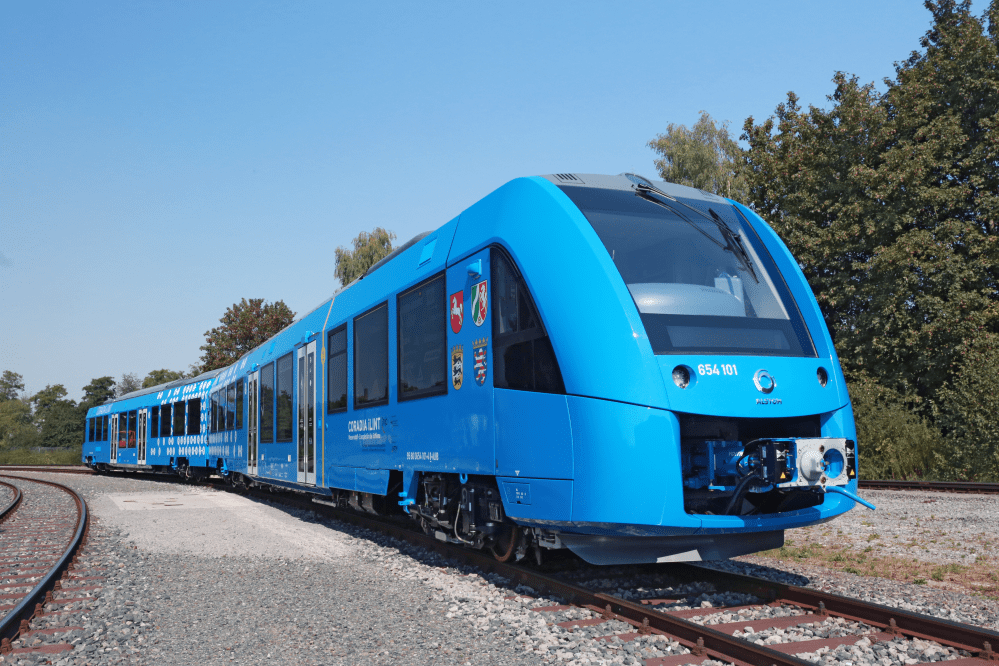While much of the hydrogen discussion in recent years has been focused on traditional light-, medium-, and heavy-duty vehicles on the road, the fuel cell industry has been expanding into new and innovative applications to move products and people on land, air, and sea. With cleaner and more efficient trains, aircraft, and sea vessels, fuel cells are helping push transportation boundaries.
Land
Traditional rail systems are typically powered by either loud and polluting diesel engines, or by electrified rail lines. Electrified rail can be effective in decarbonizing train systems for urban areas and shorter trips, however, the cost of line electrification for long-distance intercity travel can be prohibitive. In addition, while hybrid diesel-electric trains are options for consideration, they only reduce reliance on diesel fuel—not eliminate it. One promising means of reducing train emissions without the need to build thousands of miles of new transmission lines is hydrogen-powered trains, or hydrail.
In September 2018, Alstom launched the world’s first hydrogen fuel cell train, the Coradia iLint, in Lower Saxony, with support from the Germany’s Federal Ministry of Economy and Transport.
In September 2018, Alstom, one of Europe’s leading locomotive suppliers, launched the world’s first hydrogen fuel cell train, the Coradia iLint, in Lower Saxony, with support from Germany’s Federal Ministry of Economy and Transport. Alstom is utilizing fuel cells from Fuel Cell and Hydrogen Energy Association (FCHEA) member Hydrogenics. Since its introduction, two of these trains have been operating in commercial service in the area, providing zero-emission rail transport for travelers on the 100-kilometer line. Fourteen additional Coradia iLint trains are planned for delivery to the area in 2021.
Following in the footsteps of Germany, countries around the world are joining the hydrogen train revolution. The United Kingdom (UK) has been eyeing hydrogen trains, with the UK Rail Safety & Standards Board working to launch a hydrail pilot project by early 2020. The East Japan Railway Company has announced a plan to test fuel cell trains in 2021 with an investment of 4 billion Yen. In August 2019, the French National Railway Company stated that it would be announcing an order of 15 hydrogen-powered trains. Canada has been exploring hydrail options for its Metrolinx system in Ontario, since completing a feasibility study in November 2017.
Considering that the United States currently lags behind many developed nations in rail electrification and primarily still relies on diesel engines to transport goods and people over long distances, hydrail could be a promising zero-emissions solution for America’s railways in the future.
Sea
Moving from the land to the sea, fuel cell-powered vessels of all shapes and sizes are also being demonstrated and deployed. Fuel cells have the potential to greatly reduce the emissions from maritime applications, while maintaining operational flexibility.
The “Water-Go-Round”, the first commercial fuel cell ferry in the world, is expected to begin operation later this year in San Francisco, California.
One such example is the “Water-Go-Round” –the first commercial fuel cell ferry in the world, which is expected to begin operation later this year in San Francisco, California. The Water-Go-Round, supported by both the state and private industry, will operate in the San Francisco Bay, ferrying up to 84 passengers at a time, and is able to travel for two days between fueling.
Beyond fuel cell ferries, there are a range of other maritime deployments of hydrogen fuel cell technology already underway. The Energy Observer, a catamaran fuel cell-powered research vessel, is currently circumnavigating the world to test this technology, using renewable electricity and carbon-free hydrogen from seawater as fuel. The European Union has funded a fuel cell-powered river vessel expected for delivery in 2021 to operate on the Rhône River in France.
A long supporter of fuel cells, the US Navy has even been exploring hydrogen fuel cell systems for its next-generation of unmanned underwater vehicles (UUVs) and over the years, has entered partnerships with FCHEA members FuelCell Energy and General Motors on projects in this space.
Air
Fuel cells are also taking off with a number of recent announcements in zero-emission hydrogen aviation.
In May of this year, the world’s first fuel cell-powered vertical takeoff and landing (eVOTL) vehicle was unveiled in Hopkinton, Massachusetts, by FCHEA member Alakai Technologies.
In May of this year, the world’s first fuel cell-powered vertical takeoff and landing (eVOTL) vehicle was unveiled in Hopkinton, Massachusetts, by FCHEA member Alakai Technologies. Named “Skai”, this vehicle is intended to be a hydrogen-powered air taxi for up to five passengers, providing zero-emission air mobility for up to 4 hours or 400 miles on a tank of fuel.
Beyond small-scale air taxis, just this August, a new technology start-up, ZeroAvia, announced a new hydrogen-fueled electric powertrain for conventional aircraft. With a target launch of 2022, this product would be supplied for regional flights for up to 500 miles for a 10-20 seat aircraft. ZeroAvia anticipates that its aircraft can reduce fuel cost by using hydrogen, combined with increased system efficiency and lower maintenance costs.
No matter the market—on land, sea, and air—these innovative developments in hydrogen fuel cell technology demonstrate that fuel cell transportation can encompass nearly every application.


